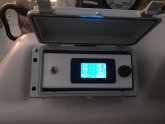Ivar Ivarson
New Member
- Joined
- Jan 30, 2020
- Messages
- 12
Self introduction on 200130 to https://diysolarforum.com/forums/newcomers.4/
I have a 20' pontoon boat, the "S.S. Hole In The Water", which I like to take on lakes in S. Ohio and on the Ohio River. I would like to construct a tiltable 20' X 8' awning on the pontoon boat. The awning could be lowered by a cable and pulley system and winch onto the boat rails for trailering and/or foul weather. The awning would have a >1500 watt PV array controlled by an MPSolar LV5048 with battery bank consisting of 2 Battery Hookup BYD 24vdc approx. 4.5KWH ABSSM LiFePO4 packs for a 48vdc system. The batteries and/or the solar panels would power a Minn-Kota eDrive 2 HP outboard electric motor (originally, a bank of four 12v 115 amp/hr lead acid batteries powered the motor but endurance on a full charge is usually about 7 hours at 1/2 speed) .
The LV5048 would act as onboard 120vac power and as 48vdc battery charger when attached on the water to "shore power" or via the PV panel array. Max motor current draw at full speed has been measured at 48vdc at 39-40 amps; 1/2 speed current draw is 11 amps. When at home, the pontoon would be parked on its trailer with the PV panels South facing to both charge batteries and feed power into the house and garage. This feed into the house would be via an pre-existing 240 vac six-circuit generator panel wired into six 'essential' circuits meaning refrigerator, freezer and lights etc. to use surplus power to offset the electric bill. However, there would not be any grid-tie as the old generator power switches have the choice of 'generator only' (or solar plant), 'off' and grid. I believe the combination of "houseboat" and/or PV residential array qualifies for the 30% Federal Income Tax credit. Of the above solar plant, only the two BYD battery packs and the generator panel have been purchased. Of course, the outboard eDrive and its speed controls came with the pontoon. Somewhat complicating our house wiring is a Generac 20kw propane powered emergency generator which automatically isolates the wiring and runs during power outages. No control interlinks between this generator and the proposed solar plant are contemplated.
I'm 70 years old, male, and fairly handy with tools and wiring but my solar experience is limited to installing a solar thermal hot water system. Eventually, I want to replicate a Wisconsin college professor's 1000 mile 1893 voyage* from near Pittsburg on the Monongahela River and down the full length of the Ohio River to Cairo, IL on the Mississippi River (although, having visited Cairo IL by car on 12/1/19, I should change the endpoint to something else).
* https://archive.org/details/afloat_onthe_ohio_1208_librivox
Comments?
I have a 20' pontoon boat, the "S.S. Hole In The Water", which I like to take on lakes in S. Ohio and on the Ohio River. I would like to construct a tiltable 20' X 8' awning on the pontoon boat. The awning could be lowered by a cable and pulley system and winch onto the boat rails for trailering and/or foul weather. The awning would have a >1500 watt PV array controlled by an MPSolar LV5048 with battery bank consisting of 2 Battery Hookup BYD 24vdc approx. 4.5KWH ABSSM LiFePO4 packs for a 48vdc system. The batteries and/or the solar panels would power a Minn-Kota eDrive 2 HP outboard electric motor (originally, a bank of four 12v 115 amp/hr lead acid batteries powered the motor but endurance on a full charge is usually about 7 hours at 1/2 speed) .
The LV5048 would act as onboard 120vac power and as 48vdc battery charger when attached on the water to "shore power" or via the PV panel array. Max motor current draw at full speed has been measured at 48vdc at 39-40 amps; 1/2 speed current draw is 11 amps. When at home, the pontoon would be parked on its trailer with the PV panels South facing to both charge batteries and feed power into the house and garage. This feed into the house would be via an pre-existing 240 vac six-circuit generator panel wired into six 'essential' circuits meaning refrigerator, freezer and lights etc. to use surplus power to offset the electric bill. However, there would not be any grid-tie as the old generator power switches have the choice of 'generator only' (or solar plant), 'off' and grid. I believe the combination of "houseboat" and/or PV residential array qualifies for the 30% Federal Income Tax credit. Of the above solar plant, only the two BYD battery packs and the generator panel have been purchased. Of course, the outboard eDrive and its speed controls came with the pontoon. Somewhat complicating our house wiring is a Generac 20kw propane powered emergency generator which automatically isolates the wiring and runs during power outages. No control interlinks between this generator and the proposed solar plant are contemplated.
I'm 70 years old, male, and fairly handy with tools and wiring but my solar experience is limited to installing a solar thermal hot water system. Eventually, I want to replicate a Wisconsin college professor's 1000 mile 1893 voyage* from near Pittsburg on the Monongahela River and down the full length of the Ohio River to Cairo, IL on the Mississippi River (although, having visited Cairo IL by car on 12/1/19, I should change the endpoint to something else).
* https://archive.org/details/afloat_onthe_ohio_1208_librivox
Comments?










